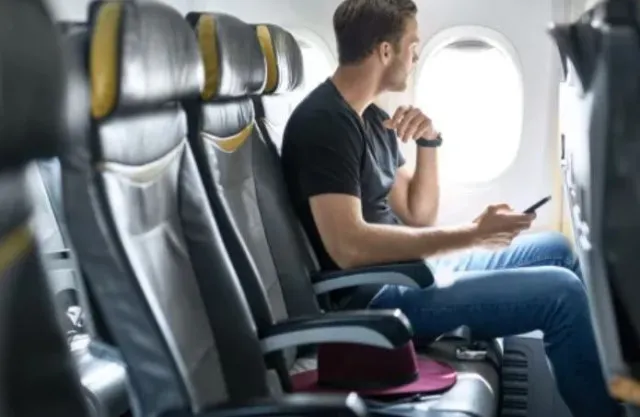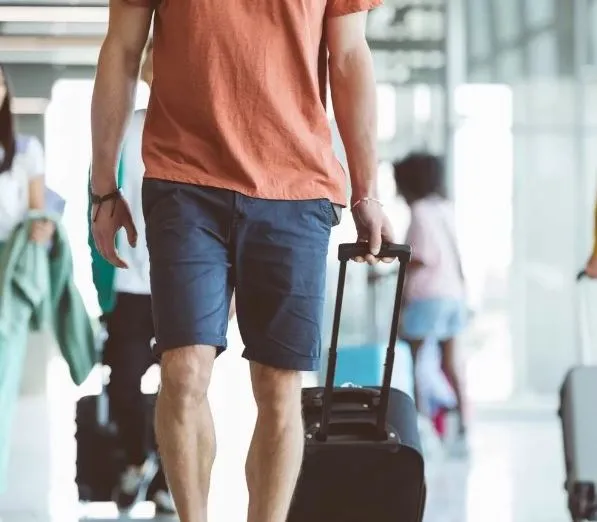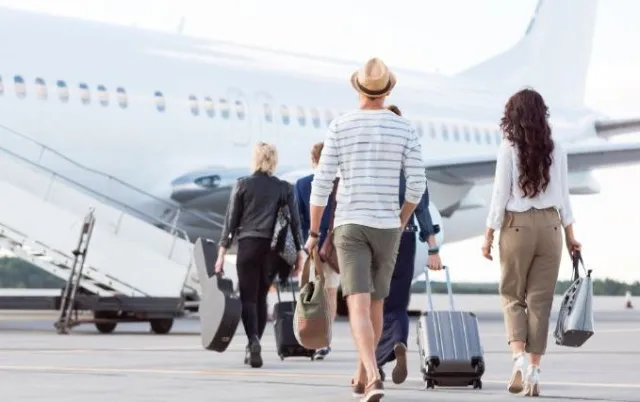When planning what to wear on a flight, most of us prioritize comfort and style. But according to Andrea Fischbach, an experienced flight attendant with American Airlines, your choice of outfit can significantly impact your safety and comfort during air travel. In an exclusive interview with Who What Wear, Andrea shared crucial insights into why certain clothing choices, like wearing a t-shirt, might not be the best idea when flying.

Andrea advises against wearing t-shirts on planes due to safety concerns. Image Credits: Getty
It’s easy to overlook the importance of what you wear on a plane, but the reality is that your outfit could make a difference in an emergency situation. Andrea Fischbach, who has spent years ensuring the safety of passengers, reveals that clothing is more than just a fashion statement—it’s a vital part of air travel safety.
One of the key pieces of advice Andrea offers is to avoid wearing t-shirts on a plane. While t-shirts might be comfortable and casual, they can leave you vulnerable in the event of an emergency. For instance, if you need to evacuate the plane using an emergency slide, the lack of coverage on your arms can result in painful friction burns.
As Andrea explains, “Emergency slides are not fun to go down and hurt—a lot—and it’s not a smooth landing once you reach the end of the slide. The more you cover the surface of your skin, the more protection for your largest organ.”
Andrea emphasizes that opting for clothing that provides more coverage, such as long sleeves and pants, can significantly reduce the risk of injury during an unforeseen event. The more fabric between your skin and potential hazards, the better protected you are. This advice extends beyond just emergency slides; it also applies to potential fire hazards or other emergencies where your clothing could play a critical role in your safety.

Clothing choices impact safety during emergencies, like evacuations. Image Credits: Getty
In addition to coverage, Andrea advises passengers to consider the material of their clothing. She recommends wearing non-flammable fabrics and avoiding items with long fringe or other embellishments that could become a hazard in the event of a fire.
“Going a bit extreme here,” Andrea notes, “but there is always a risk with long fringe should the plane have a fire. While our uniforms have polyester in them, I always wonder and worry myself that they could be a hazard if they got too close to extreme heat and melt on us.”
By choosing non-flammable fabrics, you can help mitigate the risk of serious injury in the event of a fire or other emergency situation on the plane.

Long sleeves and pants offer more protection than t-shirts. Image Credits: Getty
Another important consideration when choosing your travel outfit is comfort, particularly on long flights. Andrea warns against wearing restrictive clothing, which can impede blood flow and increase the risk of Deep Vein Thrombosis (DVT).
Loose-fitting attire is not only more comfortable but also helps mitigate the risk of serious health complications during extended periods of sitting. “The more restrictive the clothing, the more it can impede blood flow and lead to issues like DVT,” Andrea cautions.
By opting for breathable, loose-fitting fabrics, you can ensure that your body remains comfortable and your circulation is not compromised during your flight.
So, if t-shirts are out, what should you wear on a plane? Andrea suggests opting for clothing that offers more protection and comfort. Long sleeves, pants, and breathable fabrics are ideal choices. These options not only safeguard your skin but also provide comfort throughout the flight. Layering is also a smart strategy, allowing you to adjust your outfit based on the cabin temperature.

Andrea advises against wearing t-shirts on planes due to safety concerns. Image Credits: Getty
Beyond just avoiding t-shirts, Andrea offers additional tips for safe and comfortable air travel. She advises travelers to wear shoes that are easy to remove and put back on, especially during security checks. Closed-toe shoes are preferable, as they offer more protection in the event of an emergency. Additionally, consider bringing a light jacket or sweater, as cabin temperatures can vary and having an extra layer can add to your comfort.
Andrea’s insights highlight a crucial aspect of air travel: the importance of being prepared for any situation. While we all hope for a smooth and uneventful flight, emergencies can and do happen. By choosing your clothing wisely, you can enhance your safety and comfort, ensuring that you’re better prepared to handle any unexpected events.
When it comes to flying, your outfit should prioritize safety and comfort over fashion. While t-shirts and trendy outfits may seem like the perfect choice for a casual flight, they can leave you vulnerable in the event of an emergency. Following Andrea Fischbach’s advice, opting for long sleeves, pants, and non-flammable fabrics can make all the difference in protecting yourself during air travel. The next time you’re planning your travel outfit, remember that safety comes first.


